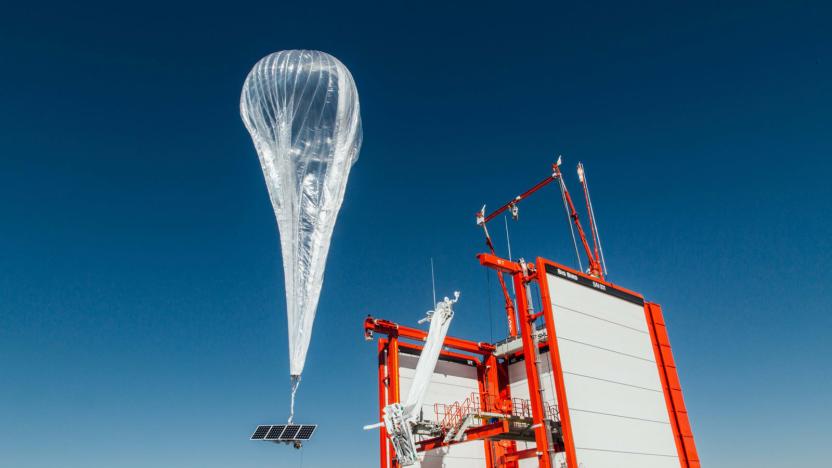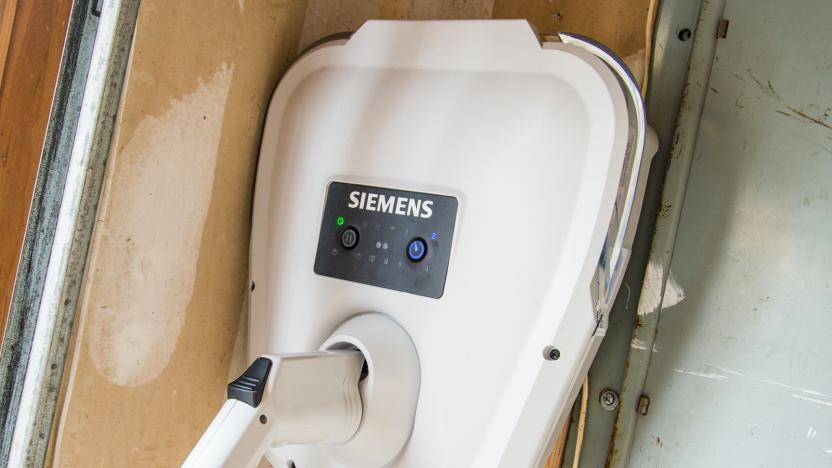aerovironment
Latest

Alphabet's Loon, telecoms unite to boost high-altitude internet
Alphabet's Loon just got a big boost from telecoms in its bid to provide high-altitude internet to the world. The company has partnered with several industry giants to form the HAPS Alliance, a group devoted to promoting the use of stratospheric vehicles for internet access. Most of the allies are telecoms like Deutsche Telekom, SoftBank, Bharti Airtel, China Telecom and Telefonica, although the group also includes a diverse range of equipment makers like Airbus, AeroVironment, Ericsson, Intelsat and Nokia.

Defense contractors took an explosive drone on a Delta flight
Employees from AeroVironment allegedly brought a drone with explosives attached to it in a carry-on bag, on a Delta flight in April 2015. As Bloomberg reports, the flight had 230 passengers and when another employee, Mark Anderson, discovered this and reported it to the Department of Defense a month later, he said he was punished, stripped of his responsibilities and then fired without a severance package.

The best EV charging stations
By Eric C. Evarts This post was done in partnership with Wirecutter. When readers choose to buy Wirecutter's independently chosen editorial picks, it may earn affiliate commissions that support its work. Read the full article here. After more than 50 hours researching over 70 charging stations for electric cars and testing five of the most promising models, we've concluded that the best for most owners of current electric vehicles (EVs) is the Siemens VersiCharge VC30GRYU, though Tesla owners should just buy Tesla's own charging station. The Siemens isn't the most powerful unit and doesn't have the most features, but it's the most convenient to use and the least expensive, and it's powerful enough to quickly charge most EVs, proving that you don't need to spend a fortune to get a great home-charging station for your electric car.

US Navy to arm its submarines with 'Blackwing' spy drones
The Navy recently announced its plans to deploy an armada of stealthy spy drones from AeroVironment aboard its submarines and UUVs. Specifically, the Navy is going with the small-form "Blackwing" UAV, a four-pound flyer with a 20 inch wingspan that collapses down to fit into a 3-inch diameter launch tube. It will use its array of electro-optical and infrared sensors as well as its anti-spoofing GPS capability to act as the submersible's remote eyes and ears.

Commercial drone allowed limited access to fly over US land
A hand-launched UAV called Puma just made history -- it's now known as the first drone to get the Federal Aviation Administration's seal of approval to do commercial flights over land. Puma, which was originally designed for military use by California company AeroVironment, has been doing surveillance work at the Prudhoe Bay oil field in Alaska since June 8th. In particular, it's using its onboard sensors to make 3D models of BP Exploration Inc.'s pipelines, roads and equipment for industrial applications. This isn't the first time Puma got the FAA's permission to fly commercially, though -- last year, the four-and-a-half-foot long drone with a nine-foot wingspan monitored drilling platforms and migrating whales over the Arctic Ocean.

FAA approves first drones for commercial operations in US airspace
Insitu's Scan Eagle X200 and AeroVironment's Puma (above) are the first UAVs to snag FAA approval for commercial operations, and they're set to take to the skies later this summer. Prior to this, the only way the private sector could fly an unmanned vessel in US airspace was with an experimental airworthiness certification -- and that cert prohibits business activities. It's worth noting that these craft weigh less than 55 pounds and measure four and a half feet long; they aren't Predator drones, by any means. Come August, a "major energy company" will use the X200 to patrol the Alaskan coast, keeping an eye on ice floes and migrating whales where the firm is doing petroleum exploration. Plans for the Puma sound slightly more action-packed, as it's expected to support oil spill emergency response-crews and watch over wildlife in the Beaufort Sea. See, this is how it all begins: First we start trusting them with our lives, then it all takes a turn for the worse. [Image credit: Wikimedia Commons]

It's not a flying fish, it's a submarine-launched UAV
VTOL may be old news already, but here's another great USP for any UAV: the ability to launch from a submerged submarine. The technology is still in development, but the Navy wants to try it from periscope depth during exercises in the Pacific Ocean next year. If all goes to plan, a Switchblade folding-wing drone will be ejected from the submarine's trash disposal unit and then carried to the surface by an SLV ('submerged launch vehicle'), which will keep it dry, point it into the wind and then hurl it heavenwards so it can go a-snooping. Whether the experiment succeeds or fails, we've glimpsed a worrying possibility: submarines are capable of dumping their trash right into the ocean. Until now, we sort of assumed they took it home with them.

AeroVironment to light up I-5 with EV chargers, add 'Oregon Trail' to the Green Highway
Retire your oxen and sell your wagon, the Oregon Trail just went electric. Okay, not the real, historic Oregon Trail, but a respectable 150-mile stretch of Interstate Five. The Oregon Department of Transportation is teaming up with AeroVironment to dot an undisclosed number of 480-volt Level 3 chargers between the California / Oregon state border and the Willamette Valley area as part the West Coast Green Highway initiative. The project aims to cover the entire I-5 corridor with electric vehicle chargers, spanning from the tip toe of the Golden State, all the way up to Washington's hat. Oregon's leg of the project should be ready for drivers this fall, making roadtrips to the Beaver State accessible to EV owners -- dysentery free. Hit the break for dry, but factual press release.

Hawaii funding deployment of up to 320 public EV chargers, islander Leafs say 'mahalo'
If you don't have far to go, an electric car can make a lot of sense. You know what group of people doesn't have far to go? People who live on an island, that's who. For this reason we're feeling some synergistic love as the State of Hawaii partners with AeroVironment, a company that also makes some goofy looking UAVs for DARPA, to deploy up to 320 public EV charging stations plugs across Kauai, Hawaii Island, Maui, and Oahu. All will be 240v Level 2 units that can charge an average EV in between four to eight hours. That's plenty of time to grab your board and get worked on some swell -- or to work on your tan if you're feeling a little less aggro. Update: Dan wrote in to let us know that Better Place is also getting a piece of this pie, securing $854,000 for "charging stations on all islands and the introduction of EVs to a rental car fleet."

DARPA-funded Nano Hummingbird spybot takes flight (video)
We were plenty impressed when we saw the initial tests of AeroVironment's robo-hummingbird -- now officially dubbed the Nano Hummingbird -- but we can't say they quite prepared us for the final product that the DARPA-funded company is now showing off. Not only does the bot look and fly like a real hummingbird (at least if you don't look too closely), but it packs a built-in camera and a downlink of some sort that's capable of transmitting live video. According to the company, the hummingbird's also able to hover for up to eight minutes, reach speeds of eleven miles per hour in forward flight, and remain stable in wind gusts of five miles per hour -- not to mention make a perfect landing. Head on past the break to check it out in action -- it may well be one of the few chances you're actually able to see one in the wild.

DARPA contractor shows off tiny robo-hummingbird UAV
We've seen plenty of tiny UAVs (or NAVs -- Nano Aerial Vehicles -- as they're also known), but none quite like the robo-hummingbird that's been in development at DARPA-contractor AeroVironment for the past couple of years. While we haven't heard much about it during that time, the company recently completed its most advanced prototype to date, dubbed Mercury, and it's taken advantage of the opportunity to show off all the progress it has made. As you can see in the video after the break, the bot is able to fly about and hover in place by mimicking the wing movement of a real hummingbird and, of course, be controlled completely untethered. What's more, the firm says that the final version will actually look like a real hummingbird as well, and be able to be controlled from up to a kilometer away -- even inside buildings, where a hummingbird won't look at all out of place.[Via Danger Room]

DARPA's Nano Air Vehicle program puts UAVs on a diet
It's not like DARPA hasn't been trying to miniaturize unmanned aerial vehicles already, but its Nano Air Vehicle program is yet another attempt to find tiny, ultra-lightweight devices that could theoretically "perform indoor and outdoor military missions." More specifically, it's looking for something less than 7.5-centimeters and under 10-grams, and the overriding goal is to "explore novel, bio-inspired, conventional and unconventional configurations to provide the warfighter with unprecedented capability for urban mission operations." Reportedly, AeroVironment already has an idea in mind for such a drone (pictured), but as these type things always go, we've no idea how soon we'll see critters like these take to the skies with a thumb-sized American flag plastered on the side.[Via BoingBoing]

US Air Force takes delivery of micro unmanned aircrafts
Shortly after the Navy announced its intentions to utilize unmanned combat aircrafts, the US Air Force is making sure it doesn't get left behind by taking delivery of "its initial BATMAV micro unmanned aircraft systems (UAS)." Among the diminutive crafts is a legion of Wasp IIIs, which have a wingspan of 29-inches, weigh in at just one-pound apiece, and carry integrated forward and side looking electro-optical color / infrared cameras. The backpackable devices are meant to be hand-launched and aim to provide "real-time video imagery to a handheld controller used by tactical units" in reconnaissance, surveillance, and target acquisition missions. Now, if only these things had an ultra-lightweight chaingun strapped under each wing and were available at the local BX, we'd be sold.[Via The Raw Feed]








